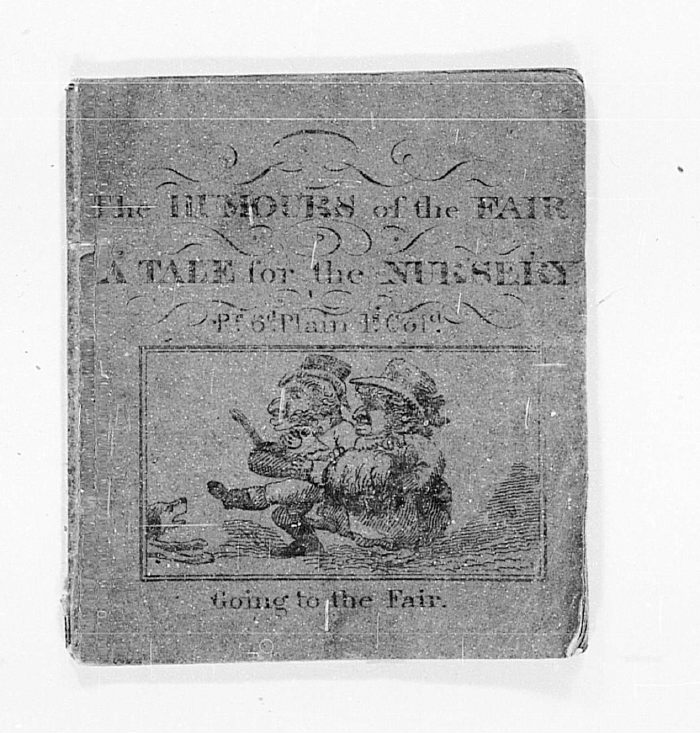Stories Before 1850. 0143: Anon., The Humours of the Fair
| Author: |
Anon. |
| Title: |
The Humours of the Fair, a Tale for the Nursery |
| Cat. Number: |
0143 |
| Date: |
No date |
| 1st Edition: |
|
| Pub. Place: |
Unknown |
| Publisher: |
Unknown |
| Price: |
6d plain, 1s coloured |
| Pages: |
1 vol., 16pp. |
| Size: |
12.5 x 10.5 cm |
| Illustrations: |
Sixteen coloured wood-cuts plus cuts on both front and back covers |
| Note: |
|
Images of all pages of this book

Introductory essay
The book describes the scene at a fair with a combination of short verses and large wood-cuts, one of each of which appears on all sixteen pages. The attractions described and depicted include a bull and a bear tied to stakes, dancing dogs, a cat playing the fiddle, all sorts of music, a strongman, a merry-go-round, wild beasts (apparently including a lion, a wolf and a bear), theatrical performances featuring Punch and Scaramouch, fire-eaters, acrobats, conjurers, jugglers, gurners, mountebanks, a donkey race, a 'galanty show' ('A shadow pantomime produced by throwing shadows of miniature figures on a wall or screen' according to the Oxford English Dictionary), and 'gay maurice [i.e. Morris] dancers'. Finally, we are told about the beggars, the bell ringers (i.e. blind?) and ballad sellers who all congregate at the fair too.
On the surface this is an uncritical representation of the fair, a celebration of the delights to be found there. As such it is rather unusual. In much late eighteenth and early nineteenth children's literature, the fair is represented as a locus of vice, or at least of the danger of undiscriminating materialism (see for instance 0040, 0115, 0251, 0249 and 0076). The fair generally appears as a testing ground where children learn the correct principles of consumerism - how to assess value and spend money wisely. Bad children fritter away their pocket money, like Harry Heedless in Virtue and Vice 'buying every idle toy that he fancied' (0249: p.12). Good children save their money until they find something of real value, which might be a present for a family member left at home, a genuinely worthwhile purchase or experience, or a needy person to whom they can make a charitable donation. However, although The Humours of the Fair seems to be mostly a celebration of the delights of the fair, and although it has no protagonist who can learn the usual lessons, the same theme of wise versus unwise consumerism runs through the book as an undercurrent. The fact that everything on offer at the fair costs, and that the performers and vendors there are operating only to try to part the audience with their money, is mentioned in many of the verses. This seems rather out of keeping with the levity of the book as a whole. The fire-eaters, dancers and conjurers 'pick up the cash at the Fair', we are pointedly told (p.6), and the pieman is characterised as taking 'A part of the cash that is wasted' (p.9). Cakes 'In the fair will, for money, be found' and the mountebank is a cheat (pp.11-12). Even the Morris-dancers 'dance the folk out of their money' (p.15).
The image on the outside back cover is very curious. Seemingly unconnected to the rest of the work, it shows 'The Wonderful Mill', an instrument operated by a tall, muscular (black?) man. The machine apprently mincing people (children?), all of whom are somehow disabled or deformed (with a wooden-leg, a crutch, a hump-back), and turning them into something else. The nature of the finished product which is being carried away by other men is unclear, but it does not seem to be human or alive.



